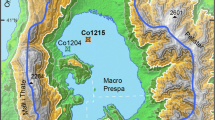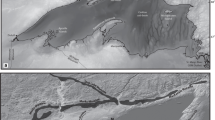Abstract
Paleontological, geochemical, and geophysical data from pluvial Lake Chewaucan, Oregon, northwestern Great Basin provide a high-resolution paleoclimate record spanning the interval (38–34 ka) that includes the Mono Lake paleomagnetic excursion, Dansgaard–Oeschger Interstadials #8–#6, and the end of Heinrich Event 4. New climate proxies presented here from the BB3-I core, whose chronology was established in a recent publication focusing on its paleomagnetic record, consist of sediment grain-size, Corg/N, ostracode faunal counts, lipid molecular stratigraphy, and palynology. They build on previously publised proxies from this basin based on environmental magnetism and supporting lithological features found in outcrop and core. Results from granulometry, geochemical analysis and the presence of the ostracode Cytherissa lacustris consistently demonstrate the correspondence of low lake conditions and colder water temperatures during Dansgaard–Oeschger stadials during a time interval including the low magnetic intensity feature of the Mono Lake Excursion, a paleomagnetic event found both in the lake core of this study and the composite Greenland ice core record between Interstadials #7 and #6. Pollen data also support this finding, suggesting colder and drier continental montane woodland conditions during stadials versus warmer and wetter semi-arid woodland conditions during interstadials. This is further supported with lipid molecular stratigraphy, indicating a consistent tendency toward terrestrial-sourced vegetation, reflecting increased stream discharge into deeper lakes during interstadials versus dominance of aquatic vegetation during low-discharge, low lake stadials. These results suggesting wet interstadials confirm those of earlier studies at Summer Lake and for other lake records in the Great Basin for millennial-scale climate change during MIS 3 age.






Similar content being viewed by others
References
Allison IS (1982) Geology of pluvial Lake Chewaucan, Lake County, Oregon. Oregon State Univ. Press, Corvallis
Antevs E (1948) The Great Basin, with emphasis on glacial and postglacial times: climatic changes and pre-white man. III. In: Bachhubber FW, Catto NR (eds) vol 38, no 20. University of Utah, Salt Lake City, pp 1–191
Bachhuber FW, Catto N (2000) Geologic evidence of rapid, multiple, and high-magnitude climate change during the last Glacial (Wisconsinan) of North America. In: McLaren SJ, Kniveton DR (eds) Linking climate change to land surface change. Springer, Dordrecht, pp 143–169
Balch DP, Cohen AS, Schnurrenberger DW, Haskell BJ, Valero-Garces BL, Beck WJ, Cheng H, Edwards L (2005) Ecosystem and paleohydrological response to quaternary climate change in the Bonneville Basin, Utah. Paleogeogr Paleoclimatol Paleoecol 221:99–122
Baldwin EM (1981) Geology of Oregon. Kendall/Hunt Publishing Company, Dubuque
Benson LV (2004) Western lakes. In: Gillespie AR, Porter SC, Atwater B (eds) The quaternary period in the United States-developments in quaternary science. Elsevier, Amsterdam, pp 185–204
Benson LV, Burdett J, Lund S, Kashgarian M, Mensing SA (1997) Nearly synchronous climate change in the Northern Hemisphere during the last glacial termination. Nature 388:263–265
Benson LV, Lund SP, Smoot JP, Rhode DE, Spencer RJ, Verosub KL, Louderback LA, Johnson CA, Rye RO, Negrini RM (2011) The rise and fall of Lake Bonneville between 45 and 10.5 ka. Quat Int 235:57–69
Benson LV, Smoot JP, Lund SP, Mensing SA, Foit FF, Rye RO (2013) Insights from a synthesis of old and new climate-proxy data from the Pyramid and Winnemucca lake basins for the period 48 to 11.5 cal ka. Quat Int 310:62–82. https://doi.org/10.1016/j.quaint.2012.02.040
Blunt AB, Negrini RM (2015) Lake levels for the past 19,000 years from the TL05-4 cores, Tulare Lake, California, USA: geophysical and geochemical proxies. Quat Int 387:122–130
Bunbury J, Gajewski K (2009) Biogeography of freshwater ostracodes in the Canadian Artic Archipelago. Arctic 62(3):324–332
Bush RT, McInerney FA (2015) Influence of temperature and C4 abundance on n-alkane chain length distributions across the central USA. Org Geochem 79:65–73
Carter C (1997) Ostracodes in core OL-92: alternation of saline and freshwater forms through time. In: Smith GI, Bischoff JL (eds) An 800,000-year paleoclimatic record from core OL-92, Owens Lake, Southeast California. Special papers, vol 317. Geol Soc Am, London, pp 113–119
Cassata WS, Singer BS, Liddicoat JC, Coe RS (2010) Reconciling discrepant chronologies for the geomagnetic excursion in the Mono Basin, California: insights from new 40Ar/39Ar dating experiments and a revised paleointensity correlation. Quat Geochronol 5:533–543. https://doi.org/10.1016/j.quageo.2010.02.001
Cohen AS, Palacios-Fest MR, Negrini RM, Wigand PE, Erbes DB (2000) A paleoclimate record for the past 250,000 years from Summer Lake, Oregon, USA: II. Sedimentology, paleontology and geochemistry. J Paleolimnnol 24(2):151–182
Dansgaard W, Johnsen SJ, Clausen HB, Dahl-Jensen D, Gundestrup NS, Hammer CU, Hvidberg CS, Steffensen JP, Sveinbjörnsdottir AE, Jouzel J, Bond G (1993) Evidence for general instability of past climate from a 250-kyr ice-core record. Nature 364(6434):218–220
Davis JO (1985) Correlation of late quaternary tephra layers in a long pluvial sequence near Summer Lake, Oregon. Quat Res 23:38–53
Decrouy L, Vennemann TW, Ariztegui D (2012) Sediment penetration depths of epi-and infaunal ostracods from Lake Geneva (Switzerland). Hydrobiologia 688(1):5–23
Delorme DL (1969) Ostracodes as Quaternary paleoecological indicators. Can J Earth Sci 6:1471–1476
Denniston RF, Asmerom Y, Polyak V, Dorale JA, Carpenter SJ, Trodick C, Hoye B, Gonzalez LA (2007) Synchronous millennial-scale climatic changes in the Great Basin and the North Atlantic during the last interglacial. Geology 35:619–622
Donath FA (1962) Analysis of Basin-Range structure, southcentral Oregon. Geol Soc Am Bull 73:1–16
Donovan LA, Richards JH, Muller MW (1996) Water relations and leaf chemistry of Chrysothamnus nauseosus ssp. consimilis (Asteraceae) and Sarcobatus vermiculatus (Chenopodiaceae). Am J Bot 83(12):1637–1646
Forester RM (1986) Determination of the dissolved anion composition of ancient lakes from fossil ostracodes. Geology 14:796–799
Forester RM, Smith, AJ, Palmer DF, Curry BB (2005) North American non-marine ostracode database “NANODe” Version 1. Kent State University, Kent. http://www.kent.edu/NANODe. Accessed 1 Mar 2015
Glover KC, MacDonald GM, Kirby ME, Rhodes EJ, Stevens L, Silveira E, Whitaker A, Lydon S (2017) Evidence for orbital and North Atlantic climate forcing in alpine Southern California between 125 and 10 ka from multi-proxy analyses of Baldwin Lake. Quat Sci Rev 167:47–62. https://doi.org/10.1016/j.quascirev.2017.04.028
Hendy IL, Kennett JP (1999) Latest Quaternary North Pacific surface-water responses imply atmosphere-driven climate instability. Geology 27(4):291–294
Hunt CO (1985) Recent advances in pollen extraction techniques: a brief review. In: Fieller NRJ, Gilbertson DD, Ralph NGA (eds) Palaeobiological investigations. British Archaeological Reports, International Series, vol 266. Oxford, pp 181–187
Johnsen SJ, Clausen HB, Dansgaard W, Fuhrer K, Gundestrup N, Hammer CU, Iversen P, Jouzel J, Stauffer B (1992) Irregular glacial interstadials recorded in a new Greenland ice core. Nature 359:311–313
Kapp RO, Davis OK, King JE (2000) Ronald O. Kapp’s Pollen and Spores. The American Association of Stratigraphic Palynologists, College Station
Kirby ME, Lund SP, Bird BW (2006) Mid-Wisconsin sediment record from Baldwin Lake reveals hemispheric climate dynamics (Southern CA, USA). Palaeogeogr Palaeoclimatol Palaeoecol 241(2):267–283
Kirby ME, Zimmerman SRH, Patterson WP, Rivera JJ (2012) A 9170-year record of decadal-to-multi-centennial scale pluvial episodes from the coastal Southwest United Sates: a role for atmospheric rivers. Quat Sci Rev 46:57–65
Lister KH (1975) Quaternary freshwater Ostracoda from the Great Salt Lake Basin, Utah. Univ Kans Paleontol Contrib 78:1–39
McCuan DT (2011) Late pleistocene geomagnetic field recorded in sediments from the depocenter of Pluvial Lake Chewaucan, lake County, OR. A thesis submitted to the Department of Geological Sciences, California State University, Bakersfield
Meyers PA, Doose H (1999) Sources, preservation, and thermal maturity of organic matter in Pliocene-Pleistocene organic-carbon-rich sediments of the western Mediterranean Sea. In: Proc. ODP. Science Results, vol 161, pp 383–390
Meyers PA, Ishiwatari R (1993) Lacustrine organic geochemistry—an overview of indicators of organic matter sources and diagenesis in lake sediments. Org Geochem 20(7):867–900
Mikolajewicz U, Crowley TJ, Schiller A, Voss R (1997) Modelling teleconnections between the North Atlantic and North Pacific during the Younger Dryas. Nature 387(6631):384–387
Moore PD, Webb JA (1978) Illustrated guide to pollen analysis. Hodder and Stoughton, London
Negrini RM, Erbes D, Faber K, Herrera A, Roberts A, Cohen A, Foit F (2000) A paleoclimate record for the past 250,000 years from Summer Lake, Oregon, USA. 1. Chronology and magnetic proxies for lake level. J Paleolimnnol 24:125–149. https://doi.org/10.1023/A:1008144025492
Negrini RM, Register C, Oseguera J, Cobos L, Hilton G, Zic M, Pezzopane S (2004) Testing and calibrating magnetic concentration parameters as lake-level proxies in a millennial-scale record from Summer Lake, Oregon, USA using independent indicators of lake-level. In: 32nd Int. geol. congr. Florence, vol 1, p 1022
Negrini RM, McCuan DT, Horton RA, Lopez JD, Cassata WS, Channell JE, Verosub KL, Knott JR, Coe RS, Liddicoat JC, Lund SP, Benson LV, Sarna-Wojcicki AM (2014) Nongeocentric axial dipole field behavior during the Mono Lake excursion. Solid Earth J Geophys Res 119:2567–2581. https://doi.org/10.1002/2013JB010846
Osborn G, Bevis K (2001) Glaciation in the Great Basin of the Western United States. Quat Sci Rev 20:1377–1410
Oster JL, Ibarra DE, Winnick MJ, Maher K (2015) Steering of westerly storms over western North America at the Last Glacial Maximum. Nat Geosci 8:201–205
Oviatt CG, Thompson RS, Kauffman DS, Bright J, Forester RM (1999) Reinterpretation of the Burmester core, Bonneville basin, Utah. Quat Res 52(2):180–184
Palacios-Fest MR, Cohen AS, Ruiz J, Blank B (1993) Comparative paleoclimatic interpretations from nonmarine ostracodes using faunal assemblages, trace elements shell chemistry and stable isotope data. Geophys Monogr Am Geophys Union 78:179
Poynter JG, Farrimond P, Robinson N, Eglinton G (1989) Aeolian-derived higher plant lipids in the marine sedimentary record: links with paleoclimate. In: Leinen M, Sarnthein M (eds) Paleoclimatology and paleometeorology: modern and past patterns of global atmospheric transport. Kluwer Academic Press, Dordrecht, pp 435–462
Rao Z, Zhu Z, Wang S, Jia G, Qiang M, Wu Y (2009) CPI values of terrestrial higher plant-derived long-chain n-alkanes: a potential paleoclimatic proxy. Front Earth Sci China 3(3):266–272
Simoneit BRT, Mazurek MA (1982) Organic matter of the troposphere—II: natural background of biogenic lipid matter in aerosols over the rural western united states. Atmos Environ 16(9):2139–2159
Simoneit BRT, Sheng G, Chen X, Fu J, Zhang J, Xu Y (1991) Molecular marker study of extractable organic matter in aerosols from urban areas of China. Atmos Environ 25A:2111–2129
Smith RJ, Janz H (2008) Recent species of the family Candonidae (Ostracoda, Crustacea) from the ancient Lake Biwa, central Japan. J Nat Hist 42(45–46):2865–2922
Sperazza M, Moore JM, Hendrix MS (2004) High-resolution particle size analysis of naturally occurring very fine-grained sediment through laser diffractometry. J Sediment Res 74(5):736–743
Stockmarr J (1971) Tablets with spores used in absolute pollen analysis. Pollen Spores 13:615–621
Svensson A, Anderen KK, Bigler M, Clausen HB, Dahl-Jensen D, Davies SM, Johnsen SJ, Muscheler R, Parrenin F, Rasmussen SO, Rothlisberger R, Seierstad I, Steffensen JP, Vinther BM (2008) A 60,000 year Greenland stratigraphic ice core chronology. Clim Past 4:47–57. https://doi.org/10.5194/cp-4-47-2008
Thompson RS, Anderson KH, Bartlein PJ (1999) Atlas of relations between climatic parameters and distributions of important trees and shrubs in North America. US Department of the Interior, US Geological Survey, Denver
Wagner G, Beer J, Laj C, Kissel C, Masarik J, Muscheler R, Synal HA (2000) Chlorine-36 evidence for the Mono Lake event in the Summit GRIP ice core. Earth Plant Sci Lett 181(1):1–6. https://doi.org/10.1016/S0012-821X(00)00196-5
Walker GW (1969) Geology of the High Lava Plains province. Oregon Dept Geol Min Ind Bull 64:77–79
Wheeler J (2007) The implications of iron-working on the woodlands of Rievaulx and Bilsdale, North Yorkshire, United Kingdom: historical, palaeoecological and palaeoenvironmental perspectives circa 1068–2000. A dissertation submitted to the Department of Archaeological and Forensic Sciences, University of Bradford, Bradford
Wigand PE, Rhode D (2002) Great Basin vegetation history and aquatic systems: the last 150,000 years. Great Basin aquatic systems history. Smithsonian contributions to earth sciences, vol 33. Smithsonian Institution Press, Washington, pp 309–367
Zic M, Negrini RM, Wigand PE (2002) Evidence of synchronous climate change across the Northern Hemisphere between the North Atlantic and the northwestern Great Basin, United States. Geology 30:635–638. https://doi.org/10.1130/0091-7613(2002)030%3c0635:EOSCCA%3e2.0.CO;2
Acknowledgements
This work was supported by the National Science Foundation Center for Research Excellence in Science and Technology (CREST) [Award #1137774] and the US Department of Education [Award #P031C80013-09].
Author information
Authors and Affiliations
Corresponding author
Rights and permissions
About this article
Cite this article
Heaton, E.J., Thompson, G., Fetzer, D.A. et al. A Great Basin lake-level response to 38–34 ka Dansgaard–Oeschger oscillations. J Paleolimnol 61, 263–278 (2019). https://doi.org/10.1007/s10933-018-0057-5
Received:
Accepted:
Published:
Issue Date:
DOI: https://doi.org/10.1007/s10933-018-0057-5




